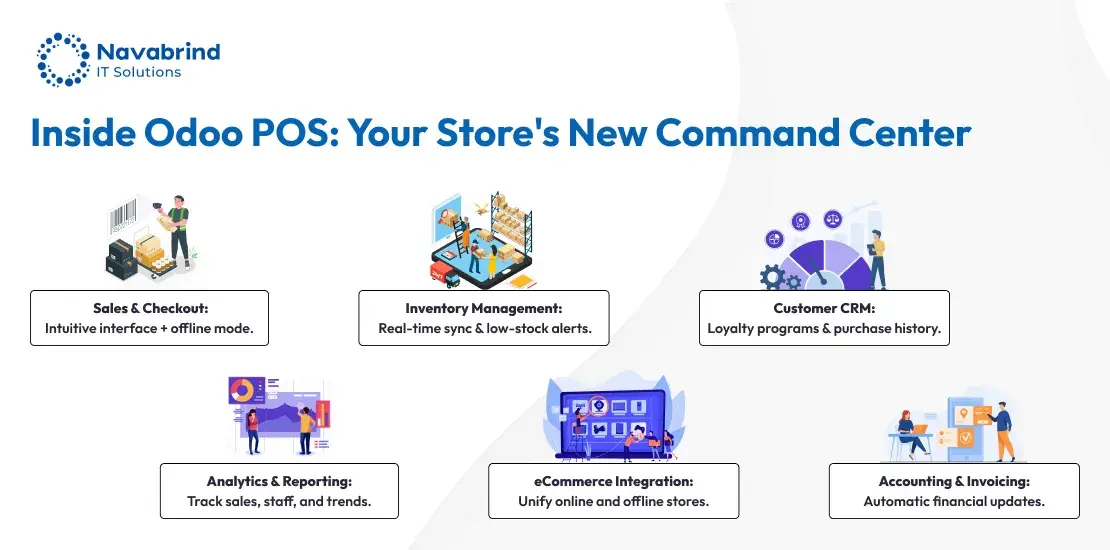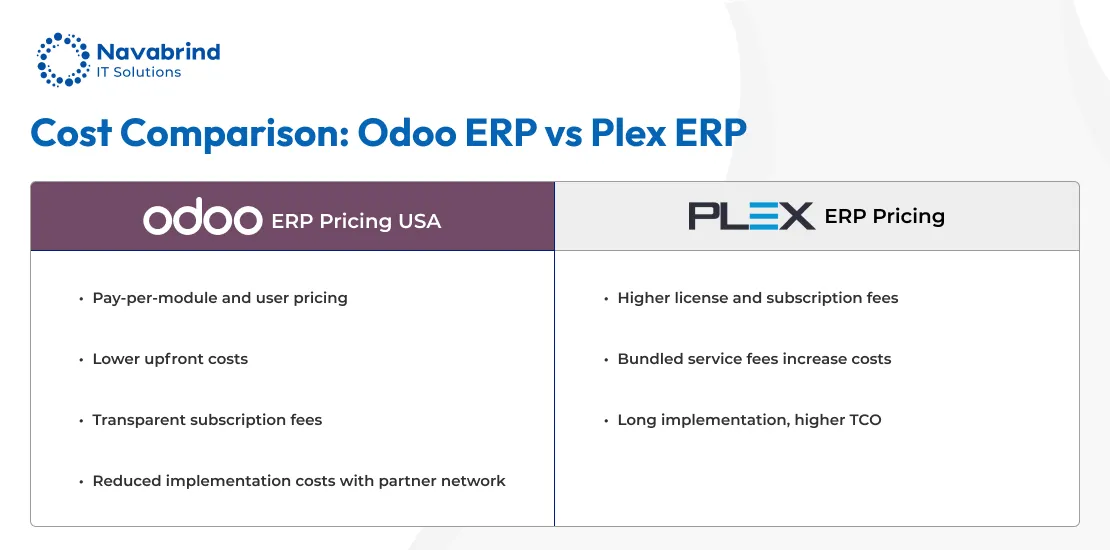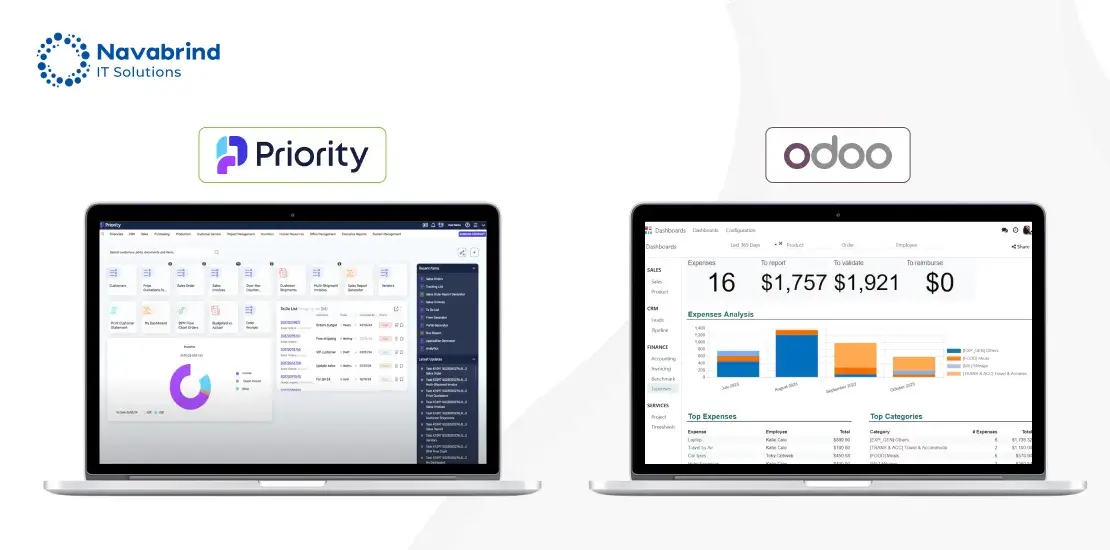Odoo vs ERPNext: Which Cloud ERP is Right for Your U.S. Business?
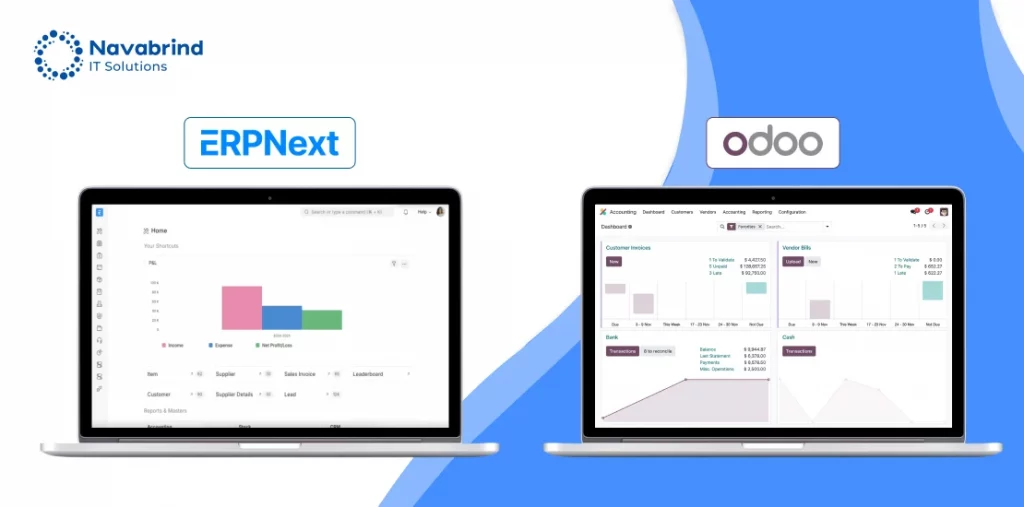
From managing finance and inventory to streamlining sales and HR, ERP platforms have become indispensable for organizations that want to cut costs, accelerate growth, and achieve a stronger ROI of ERP for American companies.
Among the many ERP platforms available, two names often stand out for small and midsize enterprises—Odoo ERP USA and ERPNext. Both platforms are cloud-ready, modular, and built to help businesses move away from siloed systems. However, companies often face a critical decision: which ERP is the better fit for their industry, scale, and budget?
This question is particularly relevant for U.S. startups and small businesses that are looking for the best ERP for U.S. startups or an affordable ERP for small business USA. For them, the right system not only ensures operational efficiency but also provides scalability as they expand. At the same time, mid-sized and growing enterprises are increasingly evaluating Cloud ERP for U.S. businesses to enable remote access, improve collaboration, and gain the flexibility to manage operations from anywhere.
With Odoo ERP pricing U.S. offering transparent plans and an extensive ecosystem supported by Odoo implementation partners USA, Odoo is emerging as a strong contender. ERPNext, on the other hand, positions itself as a cost-effective, open-source solution with appeal for businesses that want simplicity and lower upfront investment.
This blog explores Odoo vs ERPNext in depth, comparing features, pricing, scalability, and overall business value. The goal is clear: to help American businesses make an informed decision on which ERP solution best aligns with their growth objectives and digital transformation journey.
Overview of Odoo
Odoo has rapidly become one of the most widely adopted ERP platforms worldwide, and its presence in the United States is steadily growing. Known for its flexibility and wide functional coverage, Odoo ERP USA is trusted by thousands of companies across industries such as manufacturing, retail, healthcare, logistics, e-commerce, and professional services. Businesses appreciate Odoo’s open-source roots combined with the reliability of its Enterprise edition, which makes it adaptable to both U.S. startups and mid-to-large enterprises.
One of Odoo’s greatest strengths lies in its modularity, scalability, and customization. With more than 40 core applications and thousands of community-developed modules, Odoo allows businesses to start small and expand their ERP ecosystem as their operations grow. This modular design makes Odoo particularly attractive for organizations looking for the best ERP for U.S. startups, since they can begin with only the modules they need—such as CRM, accounting, or inventory—and add more advanced functionalities like manufacturing, HR, or e-commerce as their requirements evolve.
For growing companies, Odoo also stands out as a powerful Cloud ERP for U.S. businesses. Its cloud-based deployment enables remote access, real-time collaboration, and secure data management—features that are increasingly essential in today’s hybrid and distributed work environments. The system’s scalability ensures that as a company expands, the ERP can seamlessly keep up without the need for costly platform migrations.
Another advantage for American businesses is the transparency of Odoo ERP pricing U.S.. The platform offers a clear, per-user, per-app model that allows organizations to control costs and align their ERP spending with business priorities. This makes Odoo not only an affordable ERP for small business USA but also a solution that delivers measurable value and a strong ROI of ERP for American companies.
Finally, successful implementation and support are made easier through a strong partner ecosystem. Odoo implementation partners USA play a key role in tailoring the system to industry-specific needs, providing integration with existing tools, and ensuring businesses get the maximum benefit from their ERP investment. This combination of flexibility, affordability, and local partner support explains why Odoo is fast becoming the ERP of choice for companies across the United States.
Overview of ERPNext
ERPNext is an open-source ERP platform that has gained traction among startups and small to mid-sized enterprises looking for simplicity and cost-effectiveness. While Odoo ERP USA has a larger market presence and partner network, ERPNext positions itself as a lightweight alternative for businesses that need essential ERP functions without the complexity or cost of enterprise-grade systems. Its community-driven development model and open-source license make it especially appealing for organizations that want full control over their software without being tied to vendor-specific pricing models.
The core strengths of ERPNext lie in its open-source flexibility, affordability, and ease of use. The system comes with prebuilt modules for accounting, CRM, HR, inventory, and project management, enabling businesses to get started quickly without high upfront investment. For many startups in the United States, ERPNext is perceived as an affordable ERP for small business USA, particularly when budget constraints are a priority and IT teams are comfortable managing open-source applications.
As a cloud-ready system, ERPNext can also be deployed as a Cloud ERP for U.S. businesses, allowing teams to access the platform remotely and collaborate across locations. However, its scalability and ecosystem are more limited compared to Odoo. While ERPNext offers sufficient capabilities for startups and SMEs, companies with more complex workflows or plans for rapid expansion may find that Odoo’s modular ecosystem, transparent Odoo ERP pricing U.S., and extensive Odoo implementation partners USA network provide stronger long-term value.
ERPNext’s target audience is clearly startups and small businesses that value simplicity, cost savings, and faster deployment. It is often chosen by companies that don’t require heavy customization or industry-specific ERP features. While it can deliver immediate benefits and help reduce software costs, its long-term ROI of ERP for American companies may be lower compared to a scalable system like Odoo, particularly when advanced integrations and large-scale operations are needed.
In short, ERPNext is best suited for organizations that want a straightforward, open-source ERP with low barriers to entry. But for businesses aiming for sustainable growth, deeper customization, and enterprise-level scalability, Odoo remains a stronger contender in the U.S. ERP market.
Feature Comparison: Odoo vs ERPNext
When evaluating Odoo ERP USA against ERPNext, it’s important to go beyond surface-level differences and examine how each system performs across key dimensions such as functionality, customization, usability, integration, and scalability. The right choice ultimately depends on a business’s size, growth plans, and appetite for flexibility versus simplicity.
1. Modules and Functionalities
Both Odoo and ERPNext provide a broad suite of modules that cover essential business functions like finance, CRM, HR, inventory, project management, and manufacturing.
- Odoo: Odoo’s strength lies in its modular ecosystem, with over 40 core apps and thousands of third-party modules. Companies can begin with just a few apps—say accounting, CRM, and inventory—and expand as needs grow. This scalability makes it ideal for companies seeking the best ERP for U.S. startups as well as mid-sized enterprises scaling up. Odoo also offers vertical-specific solutions, making it adaptable for industries ranging from retail to manufacturing.
- ERPNext: ERPNext offers a solid set of core modules out-of-the-box, but the scope is narrower compared to Odoo. While sufficient for small businesses, it may not fully meet the needs of complex operations or rapidly growing enterprises.
2. Customization & Flexibility
- Odoo: Odoo is highly customizable, offering both low-code/no-code tools for simple adjustments and advanced technical capabilities for deeper modifications. Supported by a large network of Odoo implementation partners USA, businesses can tailor workflows, dashboards, and integrations to their exact requirements. This flexibility supports long-term scalability and improves the ROI of ERP for American companies.
- ERPNext: Customization is possible but more technical expertise is often required. Smaller businesses without in-house IT resources may find these adjustments challenging, limiting ERPNext’s appeal beyond basic use cases.
3. User Experience (UI/UX)
- Odoo: Odoo has invested heavily in modern design and intuitive navigation. Its interface is clean, mobile-responsive, and user-friendly, making adoption smoother across departments. This reduces training costs and enhances productivity—a significant benefit for companies evaluating Odoo ERP pricing U.S. in terms of overall value.
- ERPNext: The UI is functional but less polished compared to Odoo. While smaller teams may find it adequate, businesses prioritizing ease of adoption and employee satisfaction may prefer Odoo’s more refined experience.
4. Integration Capabilities
- Odoo: Odoo excels in integrations, offering both native connectors and a wide ecosystem of third-party apps. Whether connecting to e-commerce platforms, payment gateways, or marketing tools, Odoo’s ecosystem is expansive. This makes it a preferred option for companies needing unified workflows under one platform.
- ERPNext: While ERPNext supports integrations via APIs, its ecosystem is smaller. Businesses often need additional development resources to achieve the same level of connectivity offered by Odoo out-of-the-box.
5. Deployment Options
- Odoo: Offers flexible deployment models including on-premise, cloud, and SaaS. For businesses exploring Cloud ERP for U.S. businesses, Odoo provides a secure and scalable option with continuous updates and mobile-friendly access.
- ERPNext: Also supports cloud and on-premise deployments, but most businesses using ERPNext rely on self-hosted setups or limited third-party hosting providers.
6. Mobile Accessibility
- Odoo: Odoo offers dedicated mobile apps with consistent functionality across devices, enabling employees to access and manage data on the go. This is especially valuable for distributed teams or field-based industries like sales and logistics.
- ERPNext: Provides mobile access through a responsive design and mobile app, but the experience is less seamless and lacks the breadth of Odoo’s mobile features.
Odoo and ERPNext both serve the ERP needs of startups and SMEs, but their strengths differ. ERPNext is best for businesses seeking simplicity and affordability, while Odoo provides a richer ecosystem, stronger customization, and broader scalability. For organizations in the U.S. aiming to maximize efficiency, transparency, and long-term returns, Odoo’s combination of modularity, transparent Odoo ERP pricing U.S., and the availability of Odoo implementation partners USA often makes it the more strategic choice. This alignment translates into a higher ROI of ERP for American companies, especially those with plans for growth and digital transformation.
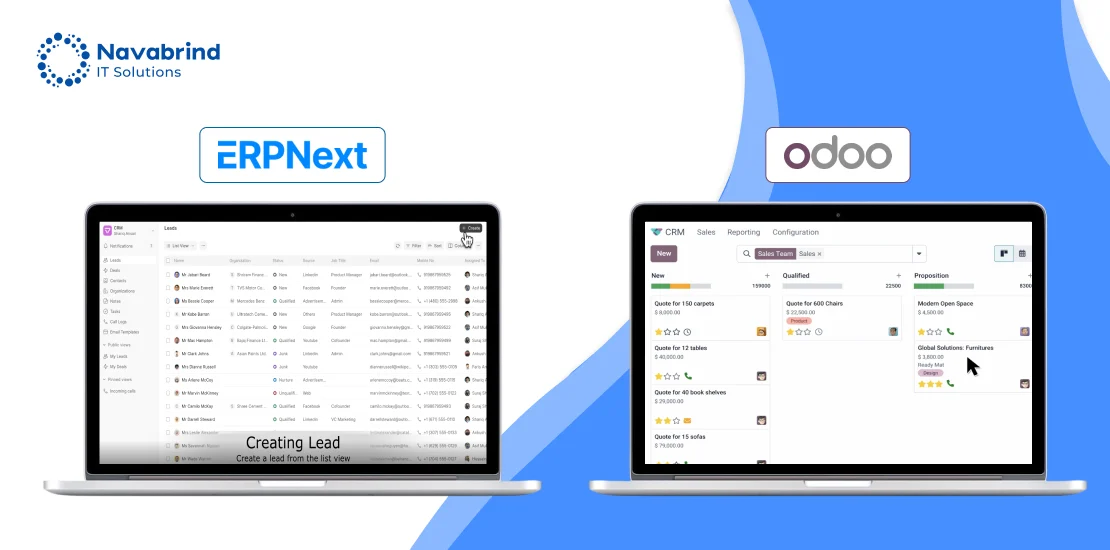
Pricing and Licensing
Pricing is often the decisive factor when businesses evaluate Odoo ERP USA and ERPNext. While both platforms aim to deliver cost savings compared to legacy ERP systems, their pricing and licensing models are quite different, influencing long-term value and scalability.
Odoo Pricing Structure
Odoo offers two editions: Community and Enterprise.
- Community Edition: Free and open-source, suitable for businesses that want to experiment with ERP at no upfront licensing cost. However, it comes with limited features and no official support.
- Enterprise Edition: Paid, with advanced features, full mobile access, and premium modules. Pricing is based on a per-user, per-app model, which gives businesses flexibility to pay only for what they use. Transparent Odoo ERP pricing U.S. allows startups and growing companies to forecast expenses and align ERP adoption with their budgets.
For U.S. startups, Odoo’s model is especially attractive because they can start small—using only the essential apps like CRM, Sales, or Accounting—and expand as they grow. This makes Odoo not only the best ERP for U.S. startups but also an affordable ERP for small business USA. With the help of certified Odoo implementation partners USA, businesses can further tailor the system to maximize efficiency and realize stronger long-term returns.
ERPNext Pricing Model
ERPNext follows an open-source licensing model, making its core software free to use. Businesses can self-host ERPNext without licensing costs, which is appealing for companies with in-house IT expertise and limited budgets. ERPNext also offers a cloud-hosted version at a subscription cost, though its ecosystem of hosting providers is narrower compared to Odoo’s SaaS options.
While ERPNext’s upfront affordability is attractive, especially for small businesses, it often requires additional investment in customization, hosting infrastructure, and ongoing maintenance. For companies without dedicated IT teams, these hidden costs can erode the initial savings.
Long-Term Cost Implications
- Odoo: The modular pricing structure makes Odoo highly scalable. As businesses expand, they can simply add users and modules without switching platforms, ensuring continuity and higher long-term ROI of ERP for American companies. Cloud and SaaS deployments also reduce IT overheads, making Odoo a strong choice for Cloud ERP for U.S. businesses.
- ERPNext: While ERPNext’s open-source model minimizes upfront expenses, scaling the system can lead to higher long-term costs in terms of custom development, integration, and infrastructure. It works best for organizations that value simplicity and can manage technical demands internally.
ERPNext is the more budget-friendly option in the short term, but Odoo’s transparent pricing, scalability, and robust support ecosystem often make it a better investment over time. For American businesses seeking both affordability and growth readiness, Odoo consistently delivers a balance of cost control and long-term value.
Support and Community
Beyond features and pricing, the level of support available can significantly influence how successful an ERP implementation will be. The differences between Odoo ERP USA and ERPNext become clear when looking at their support models and communities.
Odoo: Official Support + Partner Network
Odoo provides structured, professional support through its Enterprise edition and a strong network of global and local partners. For U.S. companies, this means access to certified Odoo implementation partners USA who can deliver tailored deployment, customization, and ongoing support services. These partners are particularly valuable for businesses that want to maximize the ROI of ERP for American companies by ensuring smooth adoption and effective use of the platform.
Odoo also offers official documentation, customer support services, and direct access to updates, making it easier for businesses to manage their systems long term. This professional support infrastructure is a key reason why Odoo is often seen as the best ERP for U.S. startups and mid-sized companies looking to scale. Combined with transparent Odoo ERP pricing U.S., businesses can align costs with their support needs, making Odoo both reliable and sustainable.
ERPNext: Community-Driven Support
ERPNext, on the other hand, relies heavily on its open-source community for support. Users can access forums, documentation, and peer-to-peer advice to resolve issues. While this can be sufficient for tech-savvy startups or businesses with internal IT expertise, the absence of an extensive professional partner network can pose challenges for companies that need hands-on guidance or industry-specific customization.
Cloud-hosted versions of ERPNext do offer some official support, but options are limited compared to Odoo’s robust partner ecosystem. For organizations prioritizing affordability, ERPNext can be appealing as an affordable ERP for small business USA, but the reliance on community-driven troubleshooting may not be ideal for companies with complex or mission-critical operations.
Enterprise vs. Community Considerations
The key difference between Odoo and ERPNext lies in the availability of enterprise-level support:
- Odoo Enterprise customers benefit from official services, updates, and dedicated technical support. This reduces downtime, ensures better security, and improves overall system performance—making it a strong choice for Cloud ERP for U.S. businesses.
- ERPNext Community Edition users depend on their own capabilities or external freelancers. While this can keep costs low, it places a greater burden on internal teams to manage and maintain the system.
In essence, companies that want structured, long-term support and guaranteed continuity often prefer Odoo, particularly with the backing of Odoo implementation partners USA. ERPNext works best for businesses with limited budgets and strong technical expertise in-house.
Scalability and Performance
When choosing an ERP, businesses must look beyond immediate needs and evaluate how well the platform will scale as operations expand. Both Odoo and ERPNext can handle small business requirements, but their ability to support growth diverges significantly, especially for companies in the U.S. market.
Odoo: Built for Growth
Odoo ERP USA is designed with scalability at its core. Its modular structure allows businesses to start with a few essential apps and add more advanced functionalities as they grow. A startup might begin with CRM, Accounting, or Inventory and later expand into Manufacturing, HR, or Marketing modules—all within the same system. This makes Odoo particularly attractive as the best ERP for U.S. startups, since it avoids costly migrations to new platforms as needs evolve.
From a performance perspective, Odoo’s Enterprise edition is optimized for large-scale deployments, with proven success stories among mid-sized and enterprise-level organizations. As a Cloud ERP for U.S. businesses, Odoo delivers high availability, mobile access, and secure data handling, making it reliable for distributed teams and companies operating across multiple geographies. Backed by certified Odoo implementation partners USA, businesses can also fine-tune performance and integrate industry-specific workflows, further improving the ROI of ERP for American companies.
ERPNext: Best for Simple Operations
ERPNext performs well for startups and smaller SMEs, especially those that value simplicity and cost savings. Its open-source nature provides flexibility, but performance can be limited when handling complex operations or high transaction volumes. Scaling ERPNext often requires additional technical expertise, infrastructure investments, or significant customization, which can erode the advantages of it being an affordable ERP for small business USA.
While ERPNext can support SMEs, it is less suited for larger enterprises or fast-growing businesses that demand advanced functionality, strong integrations, and enterprise-grade reliability. Its smaller ecosystem compared to Odoo also means fewer prebuilt tools for scaling efficiently.
Suitability by Business Size
- Startups: Both platforms are viable, but Odoo offers a clearer growth path thanks to its modular design and transparent Odoo ERP pricing U.S.. ERPNext is appealing for tech-savvy startups with minimal budgets but may require migration later.
- SMEs: Odoo is generally a stronger option, balancing affordability with advanced features and customization. ERPNext fits simpler use cases where growth ambitions are modest.
- Large Enterprises: Odoo clearly outperforms ERPNext here, offering enterprise-ready scalability, a large partner ecosystem, and cloud deployments capable of handling complex workflows at scale.
While ERPNext is a good fit for small businesses seeking an affordable, open-source ERP, Odoo delivers stronger long-term scalability, performance, and value. For American companies with ambitions to grow, Odoo’s flexibility, partner network, and reliable performance often translate into higher returns and sustainable success.
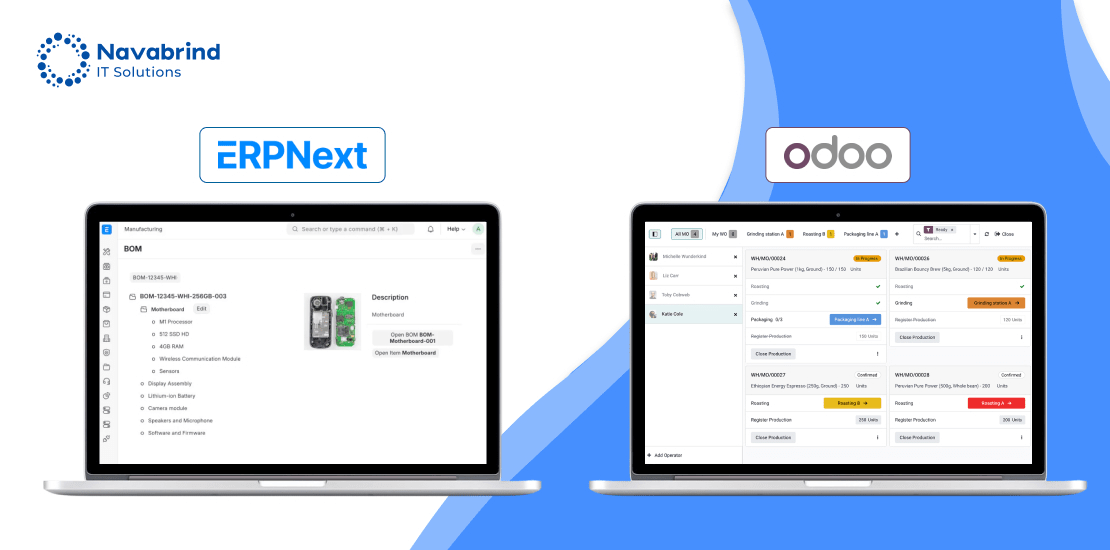
Pros and Cons of Odoo vs ERPNext
Both Odoo and ERPNext have compelling strengths, but the best choice depends on a company’s size, budget, and growth goals. To make the decision clearer, here’s a side-by-side comparison of their advantages and drawbacks.
|
Aspect |
Odoo ERP USA |
ERPNext |
|
Strengths |
– Modular ecosystem with 40+ core apps and thousands of third-party integrations. – Transparent Odoo ERP pricing U.S. (per-user, per-app model). – Highly customizable with low-code/no-code tools and developer flexibility. – Backed by certified Odoo implementation partners USA for professional support. – Reliable Cloud ERP for U.S. businesses, ensuring scalability and mobile accessibility. – Proven ROI of ERP for American companies through efficiency and long-term growth. |
– 100% open-source core system with no licensing fees. – Out-of-the-box modules for finance, HR, CRM, and projects. – Simpler, lightweight setup ideal for smaller teams. – Good choice as an affordable ERP for small business USA. – Community-driven improvements and global open-source support. – Faster adoption for businesses with strong in-house IT teams. |
|
Weaknesses |
– Enterprise edition requires licensing costs; may be higher upfront than ERPNext. – Customization can add complexity without the right partner. – Some smaller businesses may find it more than they need initially. |
– Limited ecosystem and fewer integrations compared to Odoo. – Scaling for mid-sized or large enterprises requires significant IT expertise. – Community support can be inconsistent; less professional partner support in the U.S. – Fewer advanced industry-specific solutions. – Long-term scalability challenges can reduce ROI of ERP for American companies. |
- Odoo is ideal for businesses that want a scalable, customizable, and professionally supported solution—making it the best ERP for U.S. startups, SMEs, and growing enterprises that prioritize long-term returns.
- ERPNext works well for startups or very small businesses that prioritize affordability and simplicity, but it may require switching systems as operations grow.
ERPNext wins on short-term affordability, but Odoo ERP USA consistently delivers stronger scalability, partner-backed support, and higher ROI of ERP for American companies.
Which ERP Should You Choose?
Selecting the right ERP system depends on your business size, industry focus, budget, and long-term growth goals. Both Odoo and ERPNext deliver strong features, but their strengths align differently with the needs of startups, SMEs, and enterprises.
When to Pick Odoo
Odoo stands out as a highly versatile solution, making it one of the top choices for Cloud ERP for U.S. businesses that plan to scale. Its modular design allows companies to start small and expand by adding applications as they grow.
- Best fit for SMEs and growing enterprises: Odoo ERP USA is trusted across industries like manufacturing, retail, logistics, healthcare, and e-commerce.
- Odoo ERP pricing U.S. is competitive and flexible, offering value while delivering enterprise-grade features.
- Businesses that want measurable returns find that the ROI of ERP for American companies is higher with Odoo because of automation, streamlined workflows, and real-time analytics.
- With a strong ecosystem of Odoo implementation partners USA, companies can rely on expert guidance for customizations, integrations, and long-term support.
For organizations with complex workflows or global ambitions, Odoo is often the best ERP for U.S. startups aiming for fast growth and for established companies needing a robust, scalable system.
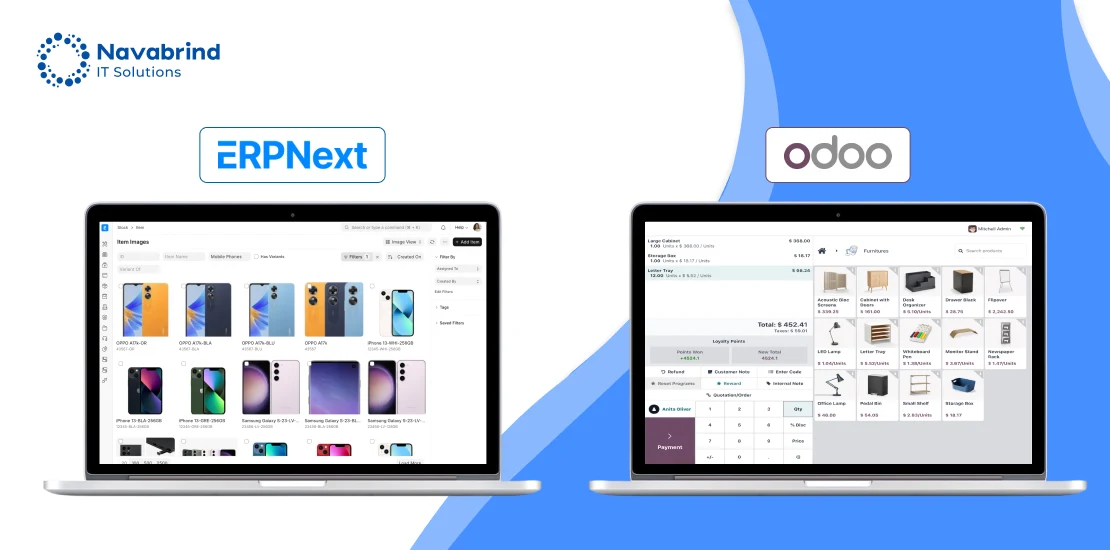
When to Pick ERPNext
ERPNext is better suited for businesses looking for an affordable ERP for small business USA that provides essential ERP functionality without heavy customization.
- Best fit for startups and micro-businesses: It provides basic modules like accounting, HR, CRM, and inventory, which meet the needs of early-stage companies.
- ERPNext’s open-source nature makes it attractive to companies that have in-house IT resources and want to control their own system without depending heavily on third-party vendors.
- While ERPNext can scale to some extent, it does not match the depth of industry-specific capabilities or the network of support that Odoo offers in the U.S. market.
Making the Right Decision
- Startups with limited budgets and simple operations may find ERPNext a cost-effective starting point.
- SMEs and enterprises with growth ambitions, multi-location operations, or industry-specific requirements will gain more value from Odoo ERP USA, especially with the availability of cloud ERP for U.S. businesses and certified implementation partners.
- Companies focused on maximizing efficiency, automation, and scalability should carefully evaluate how the ROI of ERP for American companies is influenced by choosing a solution that grows with them—an area where Odoo consistently delivers stronger results.
Odoo vs ERPNext: Pros, Cons, and ROI for American Companies
Choosing the right ERP is not about finding the most feature-rich platform, but about selecting the system that aligns with your business strategy, industry needs, and growth plans. Both Odoo and ERPNext offer value, but they cater to different types of businesses.
ERPNext is often the more affordable ERP for small business USA, particularly for startups or micro-companies with straightforward processes and limited budgets. It offers the basics of ERP functionality without heavy customization, making it a good entry-level system.
Odoo ERP USA, on the other hand, delivers a more scalable and versatile solution. With its modular apps, flexible deployment, and strong ecosystem of Odoo implementation partners USA, it adapts seamlessly to SMEs and enterprises. For companies focused on measurable efficiency and digital transformation, Odoo provides superior automation, integration, and reporting capabilities. Combined with transparent Odoo ERP pricing U.S., it consistently proves to maximize the ROI of ERP for American companies.
For best ERP for U.S. startups with growth ambitions, or for established firms seeking a robust Cloud ERP for U.S. businesses, Odoo emerges as the stronger long-term investment. Ultimately, the decision comes down to evaluating your budget, complexity of operations, and strategic growth vision—and aligning your ERP choice accordingly.
Frequently Asked Questions
1. Which is better: Odoo or ERPNext for small businesses and startups?
When it comes to choosing between Odoo ERP USA and ERPNext, small businesses and startups often prioritize affordability, ease of use, and the ability to scale as they grow. ERPNext is an open-source platform that appeals to startups with limited budgets because it provides a wide range of core functionalities without upfront licensing costs. However, while ERPNext is cost-effective, it may lack the level of customization, integrations, and ecosystem maturity that U.S. startups often need to compete in highly dynamic markets.
Odoo, on the other hand, has emerged as one of the best ERP for U.S. startups because of its modular design and ability to scale from a few essential apps to a fully integrated Cloud ERP for U.S. businesses. Startups can begin with affordable Odoo modules such as CRM, accounting, or e-commerce, and add advanced functionality like inventory, manufacturing, or HR as they grow. This modular approach ensures that startups pay only for what they need, while still benefiting from a unified system that eliminates data silos.
Another key factor is support. With Odoo implementation partners USA, small businesses and startups can access expert guidance, best practices, and reliable support during deployment and customization. This ensures faster ROI and fewer risks compared to relying solely on ERPNext’s community-driven support. For startups aiming for rapid growth and scalability, Odoo is often the stronger long-term investment, delivering better alignment with evolving business strategies.
2. How does Odoo ERP pricing U.S. compare to ERPNext’s open-source model?
The question of cost is often central when businesses weigh Odoo ERP pricing U.S. against ERPNext’s open-source model. ERPNext can appear more affordable upfront because it is free to download and use in its community version. However, the hidden costs come from hosting, custom development, and ongoing maintenance, which typically require technical expertise. This can stretch limited IT resources in small business USA setups and dilute the perceived savings over time.
Odoo offers both a Community (free) and an Enterprise (paid) version. The Enterprise edition provides advanced modules, dedicated support, security updates, and scalability features that are critical for American companies operating in competitive industries. While there is a licensing cost, Odoo is still considered an affordable ERP for small business USA because businesses can start with a small set of applications and expand as budgets allow. This pay-as-you-grow approach is attractive for startups and SMEs that want predictable costs and measurable value.
Moreover, the presence of Odoo implementation partners USA helps optimize deployment, reducing customization costs and ensuring faster returns. When factoring in the ROI of ERP for American companies, Odoo’s structured pricing often proves more sustainable in the long run. ERPNext is an attractive choice for tech-savvy startups with strong in-house teams, but for businesses seeking reliability, scalability, and professional support, Odoo ERP USA provides a stronger balance between cost and long-term business value.
3. Which ERP offers better features and modules: Odoo ERP USA or ERPNext?
When evaluating features and modules, Odoo ERP USA has a clear advantage due to its extensive ecosystem of applications covering almost every business function—finance, CRM, sales, HR, manufacturing, inventory, e-commerce, project management, and more. One of Odoo’s biggest strengths is its modularity: businesses can start with a few apps and expand into more advanced functionalities as their operations scale. This makes Odoo a strong contender for companies seeking flexibility and end-to-end coverage, especially when supported by Odoo implementation partners USA who can tailor the system to industry-specific needs.
ERPNext also provides a solid suite of modules, particularly appealing to startups and SMEs that need an affordable ERP for small business USA. It covers core functions like accounting, sales, HR, and inventory in a straightforward and easy-to-use way. However, ERPNext’s feature set is narrower compared to Odoo, and while it works well for businesses with simple requirements, it often requires custom development for advanced or niche industry needs. This makes it less versatile for companies looking to scale quickly or manage complex operations.
For companies aiming to maximize the ROI of ERP for American companies, Odoo stands out because of its strong integration capabilities, wider third-party ecosystem, and professional partner support. While ERPNext may work well for early-stage startups, Odoo is widely considered the best ERP for U.S. startups and SMEs that want advanced functionality, scalability, and the ability to align ERP systems with long-term growth strategies.
4. Is Odoo or ERPNext better suited for Cloud ERP for U.S. businesses?
Both Odoo and ERPNext offer cloud deployment options, but Odoo ERP USA provides more flexibility and enterprise-grade capabilities for Cloud ERP for U.S. businesses. Odoo offers SaaS (Odoo Online), on-premise hosting, and third-party cloud hosting options, giving businesses the ability to choose deployment models that align with their security, compliance, and scalability needs. This flexibility is especially valuable for American companies that operate across multiple states or geographies and need mobile-friendly, cloud-accessible ERP solutions.
ERPNext, as an open-source system, also offers cloud deployment but is primarily dependent on either community hosting or self-managed infrastructure. While this can work well for startups with strong technical teams, it often creates challenges for less tech-savvy businesses that need reliable uptime, advanced security, and professional-grade support. For many U.S. businesses, the lack of a large partner ecosystem and enterprise-level hosting options can make ERPNext less attractive when compared to Odoo.
With Odoo implementation partners USA, companies gain access to cloud migration expertise, ongoing support, and tailored deployments that ensure long-term scalability. Considering the Odoo ERP pricing U.S. model, businesses can also start small and expand their cloud usage over time without overstretching budgets. For organizations that prioritize resilience, flexibility, and long-term returns, Odoo consistently delivers stronger ROI of ERP for American companies through its cloud-first strategy.
5. What kind of support is available: Odoo implementation partners USA vs ERPNext’s community support?
One of the major differences between Odoo ERP USA and ERPNext lies in the type and depth of support available. Odoo offers a robust global ecosystem of certified Odoo implementation partners USA, who provide consulting, deployment, customization, and post-go-live support. This partner-driven model ensures that U.S. businesses can access localized expertise, best practices, and industry-specific configurations that help maximize the ROI of ERP for American companies. Odoo also provides official enterprise support with SLA-backed services, which gives companies peace of mind for critical operations.
ERPNext, on the other hand, relies heavily on its open-source community for support. While the community is active and offers forums, documentation, and some vendor-backed services, it doesn’t provide the same level of professional-grade support that many growing U.S. businesses require. For startups and smaller companies looking for an affordable ERP for small business USA, ERPNext’s community support can be sufficient if they have in-house technical teams capable of handling issues independently. However, it may not be suitable for organizations with complex requirements or limited technical expertise.
In practice, this means that U.S. businesses seeking guaranteed uptime, faster resolution times, and professional accountability often lean toward Odoo. The availability of Odoo implementation partners USA ensures that companies not only adopt ERP successfully but also adapt it over time to match evolving business needs—something that is harder to achieve with ERPNext’s community-driven approach.
6. Which ERP scales better with business growth: Odoo ERP USA or ERPNext?
Scalability is one of the most critical factors when choosing an ERP system, and here, Odoo ERP USA generally outperforms ERPNext. Odoo’s modular architecture allows businesses to start with a few core applications and gradually add more advanced modules as they grow. Whether it’s expanding into manufacturing, international accounting, or advanced supply chain management, Odoo provides the flexibility needed for Cloud ERP for U.S. businesses of all sizes. This adaptability makes Odoo a top choice for companies that want to future-proof their systems and ensure strong long-term returns.
ERPNext is well-suited for startups and SMEs that need a simple, open-source ERP without heavy customization. However, as business needs become more complex, ERPNext often requires significant custom development to scale effectively. This can limit its appeal for companies planning rapid expansion or those operating across multiple industries. While ERPNext remains an option for the best ERP for U.S. startups on a budget, its scalability is less robust compared to Odoo’s enterprise-ready architecture.
For American businesses evaluating the Odoo ERP pricing U.S. model against ERPNext’s open-source costs, the long-term picture often favors Odoo. With professional support, a growing ecosystem of third-party integrations, and strong partner backing, Odoo enables smoother scaling and delivers better ROI of ERP for American companies. This makes it the preferred choice for SMEs transitioning into larger enterprises or startups with aggressive growth trajectories.
Schedule a conversation with us now!
Related Articles
-
Post
Streamline Your Store: A Deep Dive into the Odoo Point of Sale System
Streamline Your Store: A Deep Dive into the Odoo Point of Sale System December 5, 2025 Posted by: Tony Category: Uncategorized No Comments The Heart of the Modern Retail Experience Picture this: a customer walks into your store, finds what she is looking for and is ready to buy. Your online store just received five -
Post
Odoo ERP vs Plex ERP: Which Open Source Powerhouse Will Transform US Manufacturing
Odoo ERP vs Plex ERP: Which Open Source Powerhouse Will Transform US Manufacturing November 27, 2025 Posted by: Tony Category: Uncategorized No Comments As demand for cost-effective ERP solutions in the USA increases, businesses are turning to the best open source ERP software, Odoo ERP USA, for a flexible, scalable, and affordable approach to digital -
Post
Why US Manufacturers are Choosing Odoo Over Priority ERP
Why US Manufacturers are Choosing Odoo Over Priority ERP November 21, 2025 Posted by: Tony Categories: Blog, Odoo No Comments Are you a mid-sized US manufacturer feeling the squeeze? Does your sales team use one system, your shop floor runs on another, and your finance department is stuck manually reconciling it all in a third.
How can we help you?
Get in touch with a solutions consultant that can share best practices and help solve specific challenges.







